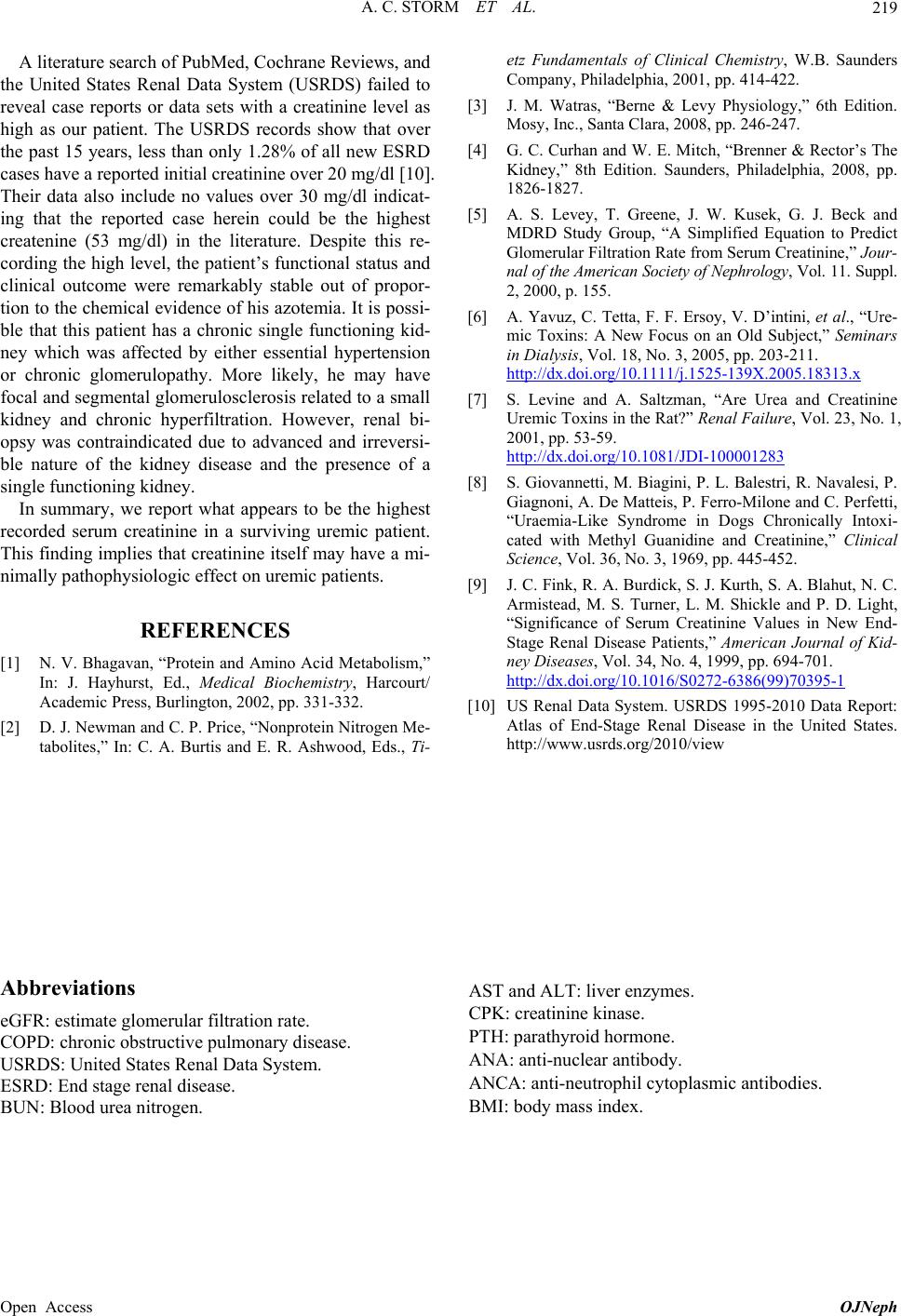
A. C. STORM ET AL.
Open Access OJNeph
219
A literature search of PubMed, Cochrane Reviews, and
the United States Renal Data System (USRDS) failed to
reveal case reports or data sets with a creatinine level as
high as our patient. The USRDS records show that over
the past 15 years, less than only 1.28% of all new ESRD
cases have a reported initial creatinine over 20 mg/dl [10 ].
Their data also include no values over 30 mg/dl indicat-
ing that the reported case herein could be the highest
createnine (53 mg/dl) in the literature. Despite this re-
cording the high level, the patient’s functional status and
clinical outcome were remarkably stable out of propor-
tion to the chemical evidence of his azotemia. It is possi-
ble that this patient has a chronic single functioning kid-
ney which was affected by either essential hypertension
or chronic glomerulopathy. More likely, he may have
focal and segmental glomerulosclerosis related to a small
kidney and chronic hyperfiltration. However, renal bi-
opsy was contraindicated due to advanced and irreversi-
ble nature of the kidney disease and the presence of a
single functio n i ng ki d ney .
In summary, we report what appears to be the highest
recorded serum creatinine in a surviving uremic patient.
This finding implies that creatinine itself may h ave a mi-
nimally pathophysiologic effect on uremic patients.
REFERENCES
[1] N. V. Bhagavan, “Protein and Amino Acid Metabolism,”
In: J. Hayhurst, Ed., Medical Biochemistry, Harcourt/
Academic Press, Burlington, 2002, pp. 331-332.
[2] D. J. Newman and C. P. Price, “Nonprotein Nitrogen Me-
tabolites,” In: C. A. Burtis and E. R. Ashwood, Eds., Ti-
etz Fundamentals of Clinical Chemistry, W.B. Saunders
Company, Philadelphia, 2001, pp. 414-422.
[3] J. M. Watras, “Berne & Levy Physiology,” 6th Edition.
Mosy, Inc., Santa Clara, 2008, pp. 246-247.
[4] G. C. Curhan and W. E. Mitch, “Brenner & Rector’s The
Kidney,” 8th Edition. Saunders, Philadelphia, 2008, pp.
1826-1827.
[5] A. S. Levey, T. Greene, J. W. Kusek, G. J. Beck and
MDRD Study Group, “A Simplified Equation to Predict
Glomerular Fi ltrat ion Rate from Serum Cre ati nine,” Jour-
nal of the American Society of Nephrology, Vol. 11. Suppl.
2, 2000, p. 155.
[6] A. Yavuz, C. Tetta, F. F. Ersoy, V. D’intini, et al., “Ure-
mic Toxins: A New Focus on an Old Subject,” Seminars
in Dialysis, Vol. 18, No. 3, 2005, pp. 203-211.
http://dx.doi.org/10.1111/j.1525-139X.2005.18313.x
[7] S. Levine and A. Saltzman, “Are Urea and Creatinine
Uremic Toxins in the Rat?” Renal Failure, Vol. 23, No. 1,
2001, pp. 53-59.
http://dx.doi.org/10.1081/JDI-100001283
[8] S. Giovannetti, M. Biagini, P. L. Balestri, R. Navalesi, P.
Giagnoni, A. De Matteis, P. Ferro-Milone and C. Perfetti,
“Uraemia-Like Syndrome in Dogs Chronically Intoxi-
cated with Methyl Guanidine and Creatinine,” Clinical
Science, Vol. 36, No. 3, 1969, pp. 445-452.
[9] J. C. Fink, R. A. Burdick, S. J. Kurth, S. A. Blahut, N. C.
Armistead, M. S. Turner, L. M. Shickle and P. D. Light,
“Significance of Serum Creatinine Values in New End-
Stage Renal Disease Patients,” American Journal of Kid-
ney Diseases, Vol. 34, No. 4, 1999, pp. 694-701.
http://dx.doi.org/10.1016/S0272-6386(99)70395-1
[10] US Renal Data System. USRDS 1995-2010 Data Report:
Atlas of End-Stage Renal Disease in the United States.
http://www.usrds.org/2010/view
Abbreviations
eGFR: estimate glomerular filtration rate.
COPD: chronic obstructive pulmonary disease.
USRDS: United States Renal Data System.
ESRD: End stage renal disease.
BUN: Blood urea nitrogen.
AST and ALT : liver enz y mes.
CPK: creatinine kinase.
PTH: parathyroid hormone.
ANA: anti-nuclear antibody.
ANCA: anti-neutrophil cytoplasmic antibodies.
BMI: body mass index.